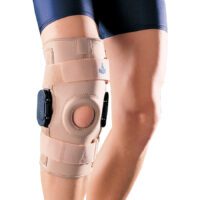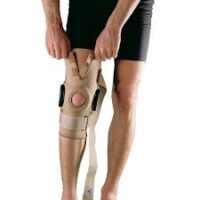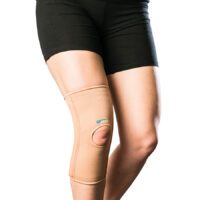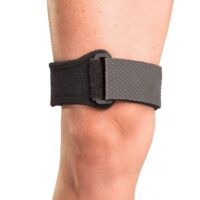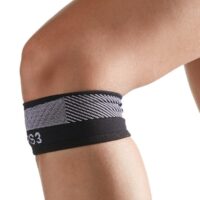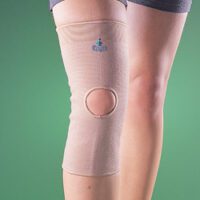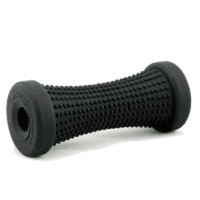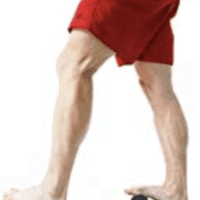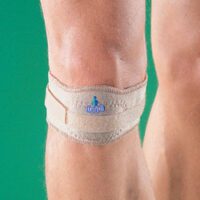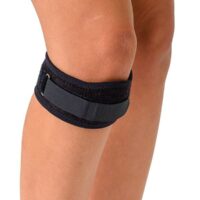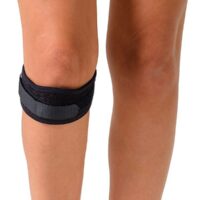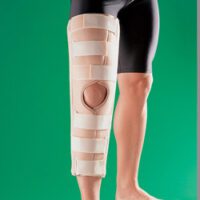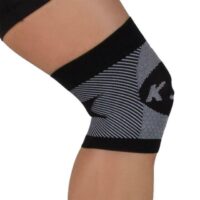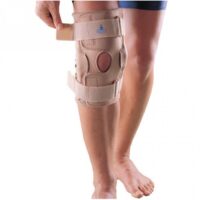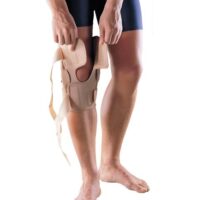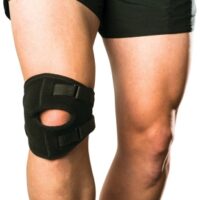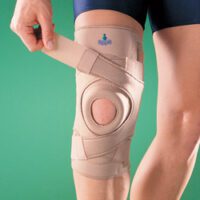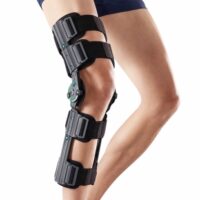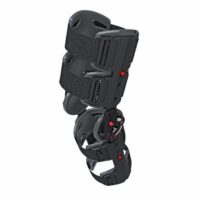Plica Syndrome
Article by John Miller

Plica Syndrome
What Causes Plica Syndrome?
Plica syndrome occurs when the medial plica in your knee becomes inflamed and irritated. This irritation can be caused by repetitive overuse or trauma to the knee. It can also occur due to incorrect alignment or movement of the patella, which can cause the plica to rub against the bone.
What is Plica Syndrome?
Plica syndrome occurs when the plica in your knee becomes inflamed. The plica is a fold of synovial membrane located in the anteromedial aspect of the knee. It is present in about 50% of the population and is a remnant of embryonic connective tissue that did not fully resorb during fetal development. While your knee may have four plicae, the medial plica is most likely to be symptomatic.
What are the Symptoms of Plica Syndrome?
If you have plica syndrome, the inflamed plica in your knee may catch during repetitive knee straightening and bending, blunt trauma or knee twisting, fat pad irritation, altered knee motion, or internal knee derangements such as meniscal tears. This can result in persistent knee pain and weakness in the quadriceps muscles. Plica syndrome often occurs concurrently with other knee conditions, such as meniscal injuries, patellar tendinopathy, and Osgood-Schlatter’s Disease.
Common symptoms of plica syndrome include pain and discomfort in your knee, which may worsen with activities such as running or climbing stairs. You may also experience a clicking or popping sensation in your knee. To diagnose plica syndrome, your doctor may check for anteromedial knee joint line pain, visible and palpably tender plica, or an audible clicking or snap during knee motion, which is painful between 30 to 60 degrees (Dupont, 1997). Additionally, a positive duvet test, where the pain is eased by using a duvet between your knees to ease the pain in bed, may also indicate plica syndrome. Activities such as ascending and descending stairs, squatting, rising from a chair, or sitting for extended periods can also cause pain (Shetty et al., 2007). Quadriceps atrophy is common in chronic cases.
How is Plica Syndrome Diagnosed?
Your physiotherapist or sports doctor can diagnose plica syndrome through a clinical examination. However, it is essential to have your knee thoroughly assessed to rule out other knee pathologies, particularly meniscal injuries.
While an X-ray may be helpful in ruling out associated pathologies, it will not identify a plica. MRIs can detect plica inflammation but are more helpful in diagnosing other pathologies related to plica irritation. Thus, a comprehensive examination by your physiotherapist or sports physician is preferable for accurate diagnosis.
Plica Syndrome Treatment
The treatment for plica syndrome involves reducing inflammation and pain through rest, ice, compression, and elevation. Physiotherapy can help correct any alignment or movement issues contributing to the condition. In severe cases, surgery may be required to remove the affected plica.
Research indicates that around 60% of patients with plica syndrome will recover successfully with conservative physiotherapy treatment within 6 to 8 weeks. The physiotherapy treatment aims to reduce pain and inflammation, improve patellofemoral alignment, normalise muscle lengths, strengthen the knee and lower limb muscles, address foot biomechanics issues, improve proprioception, agility and balance, and enhance lower limb function and quality of movement.
After a thorough examination, it is essential to discuss your knee injury with a knee clinician such as a physiotherapist, sports physician or knee surgeon. This approach can minimise the chances of re-aggravating your plica syndrome.
Plica Surgery
Consider undergoing arthroscopic knee surgery to treat plica syndrome that persists beyond 3 to 6 months. The surgery involves performing a lateral retinaculum release to allow the patella to track more medially, which can alleviate plica irritation as it rolls over the medial femoral condyle. The surgery has a success rate exceeding 85%. (Gerbino et al. 2007).
How to Prevent Plica Syndrome?
It is essential to take proactive measures to manage knee injuries. This includes maintaining normal knee joint alignment, adequate strength and flexibility in the muscles around the knee joint and the rest of the lower limb, wearing appropriate footwear that supports foot biomechanics, and considering weight management as a long-term preventative measure to reduce pressure on lower limb joints.
Patients with plica irritation may try using a knee brace to alleviate pain. An effective patellofemoral brace can be a helpful alternative to kneecap taping.
Rochedale - Call 38410277
Book Online: RochedaleSalisbury - Call 32751044
Book Online: SalisburySandgate - Call 32691122
Book Online: SandgateArticle by John Miller
Knee Pain Causes
Knee Pain Causes: An In-Depth Guide from a Physiotherapist's Perspective
Knee pain is a common complaint that can significantly impact your daily life. Understanding the causes of knee pain is crucial for effective treatment and prevention. This guide explores various knee pain causes and provides insights from a physiotherapist's perspective.


Common Causes of Knee Pain
Knee pain can stem from a variety of sources, ranging from acute injuries to chronic conditions. Let's explore some common causes:
Ligament Injuries
Ligament injuries are a significant cause of knee pain. These injuries often occur during sports or high-impact activities.
- ACL Injury: The Anterior Cruciate Ligament (ACL) is crucial for knee stability. ACL injuries can result from sudden stops or changes in direction. Symptoms include pain, swelling, and instability. Treatment often involves surgery and rehabilitation.
- PCL Injury: The Posterior Cruciate Ligament (PCL) can be injured in direct trauma to the knee. This injury also leads to pain and swelling, with treatment options ranging from physical therapy to surgery.
- MCL and LCL Sprains: Medial Collateral Ligament (MCL) and Lateral Collateral Ligament (LCL) sprains result from direct blows to the knee. These injuries cause pain and instability, often requiring rest, bracing, and physiotherapy.
Meniscus Injuries
Meniscus tears are another common knee injury. The meniscus is a cartilage that cushions the knee joint.
- Meniscus Tear: This injury often occurs from twisting or rotating the knee while bearing weight. Symptoms include pain, swelling, and difficulty moving the knee. Treatment options vary based on the tear's severity, ranging from rest and physiotherapy to surgery.
- Discoid Meniscus: This congenital condition results in an abnormally shaped meniscus, leading to pain and instability. Treatment may involve surgery to reshape or remove the meniscus.
Kneecap Pain
Several conditions can cause pain in the kneecap area, affecting your ability to perform daily activities.
- Chondromalacia Patella: Also known as "runner's knee," this condition involves the softening and breakdown of the cartilage on the underside of the kneecap. It causes pain and swelling, particularly when walking up stairs or sitting for long periods.
- Patellar Tendinopathy: Also called "jumper's knee," this condition results from overuse, causing pain at the front of the knee. Treatment typically includes rest, physiotherapy, and strengthening exercises.
- Patellofemoral Pain Syndrome: This condition involves pain around the kneecap, often resulting from overuse or misalignment. Treatment includes rest, physiotherapy to improve the patellar tracking, and proper footwear.
Knee Arthritis
Arthritis is a leading cause of knee pain, particularly in older adults. It causes inflammation and stiffness in the joints.
- Knee Osteoarthritis: This degenerative condition involves the wearing down of cartilage, leading to pain and swelling. Treatment includes physiotherapy, medication, and sometimes surgery.
- Rheumatoid Arthritis: This autoimmune condition causes inflammation in the knee joints. It requires medical management and physiotherapy to manage symptoms.
Knee Tendon Injuries
Tendon injuries can result from overuse or sudden, high-impact activities.
- Patellar Tendinopathy: This injury involves the patellar tendon, causing pain below the kneecap. Treatment includes rest, physiotherapy, and strengthening exercises.
- Quadriceps Tendinopathy: This condition affects the tendon connecting the quadriceps muscles to the knee, leading to pain above the kneecap.
Muscle Injuries
Muscle strains and related conditions are common knee pain causes, especially among athletes and active individuals.
- Hamstring Strain: This injury involves the muscles at the back of the thigh. It causes pain, swelling, and difficulty bending the knee. Treatment includes rest, ice, and physiotherapy.
- ITB Syndrome: The Iliotibial Band (ITB) can become tight and inflamed, leading to pain on the outer side of the knee. Stretching and physiotherapy are essential for recovery.
Knee Bursitis
Inflammation of the bursae, small fluid-filled sacs around the knee, can cause significant pain.
- Knee bursitis: Suprapatella bursitis is a common knee bursitis.
- Pes Anserine Bursitis: This condition involves inflammation of the bursa located on the inner side of the knee. It causes pain and swelling, with treatment focusing on reducing inflammation through rest, ice, and physiotherapy.
Children’s Knee Conditions
Young athletes can experience specific knee conditions related to growth and activity levels.
- Osgood Schlatter’s Disease: This condition involves inflammation of the area just below the kneecap where the tendon from the kneecap attaches to the shinbone. It causes pain and swelling, especially during activities.
- Sinding Larsen Johansson Syndrome: This condition affects the growth plate at the bottom of the kneecap, leading to pain and swelling.
Other Knee-Related Conditions
Various other conditions can lead to knee pain, necessitating a broad understanding of potential causes.
- Runner’s Knee: This condition involves pain around the kneecap, often resulting from overuse or misalignment. Treatment includes rest, physiotherapy, and proper footwear.
- Plica Syndrome: Inflammation of the plica, a fold in the knee lining, can cause pain and swelling. Physiotherapy and anti-inflammatory medications are common treatments.
What to Do?
If you're experiencing knee pain, seeking professional advice from a physiotherapist is essential. They can provide a personalised assessment and treatment plan to address your specific needs. Early intervention can significantly improve your outcomes and help you return to a pain-free, active lifestyle.
Conclusion
Understanding the causes of knee pain is the first step towards effective treatment. By addressing the root cause, you can find relief and prevent future issues. Consult a physiotherapist to develop a tailored plan for your knee health.
Rochedale - Call 38410277
Book Online: RochedaleSalisbury - Call 32751044
Book Online: SalisburySandgate - Call 32691122
Book Online: SandgateKnee Pain Causes FAQs
- What are the main causes of knee pain?
- Common causes include ligament injuries, meniscus tears, kneecap pain, arthritis, tendon injuries, muscle strains, and bursitis.
- How can I tell if my knee pain is serious?
- Serious knee pain often involves significant swelling, inability to bear weight, or visible deformity. Consult a physiotherapist or doctor if you experience these symptoms.
- Can knee pain be treated without surgery?
- Yes, many knee pain causes can be treated with physiotherapy, rest, and non-surgical interventions.
- What is the best treatment for knee pain?
- The best treatment depends on the cause. Physiotherapy, rest, strengthening exercises, and sometimes medication or surgery are effective options.
- How can I prevent knee pain?
- Prevent knee pain by maintaining a healthy weight, staying active, wearing proper footwear, and doing strength and flexibility exercises.
- When should I see a physiotherapist for knee pain?
- See a physiotherapist if your knee pain persists for more than a few days, is severe, or affects your ability to perform daily activities.
Related Articles
- Knee Osteoarthritis - Discover effective treatments for knee osteoarthritis.
- ACL Injuries - Learn about symptoms and treatment options for ACL injuries.
- Meniscus Tear - Understand the causes and treatments for meniscus tears.
- Patellar Tendinopathy - Explore treatment options for patellar tendinopathy.
- ITB Syndrome - Find out how to manage and treat ITB syndrome.
- Hamstring Strain - Tips for recovering from a hamstring strain.
- Runner’s Knee - Effective strategies to reduce knee stress for runners.
- Knee Arthroscopy - Learn about this surgical option for knee injuries.
- Quadriceps Tendinopathy - Understand the causes and treatments for this condition.
- Knee Bursitis - Discover ways to reduce inflammation and pain from knee bursitis.
These articles provide detailed information on various knee conditions and their treatments.
Knee Pain FAQs
Knee pain is a widespread issue, impacting individuals of varying ages and lifestyles. Causes range from injuries and wear and tear to conditions like arthritis. This FAQ section aims to provide insights into knee pain, covering diagnosis, ligament issues, ACL injuries, meniscal injuries, age and arthritis concerns, and pain relief methods through exercise and treatment.
Feel free to click on the questions to for deeper discussions into each topic.


Diagnosis Related
How Can I Determine If My Knee Injury Is Serious?
- Learn to assess the severity of your knee injury based on symptoms and situations.
How Can I Identify The Type Of Knee Injury I Have?
- Discover how different knee injuries manifest and what signs to look for.
When Should I Seek a Physiotherapist or Doctor for My Knee Injury?
- Find out the right time to consult professionals for your knee concerns.
Is Knee Clicking a Sign of a Serious Condition?
- Understand what knee clicking indicates about your joint health.
When Should I Consider Getting a MRI for My Knee?
- Learn about the circumstances when an MRI becomes necessary.
Why Has My Knee Suddenly Started Hurting?
- Explore potential reasons behind sudden knee pain.
Why Does My Knee Hurt On The Inner Side?
- Identify causes of inner knee pain and when to seek help.
Knee Ligament Related
What Are The Common Symptoms of a Torn Ligament in the Knee?
- Recognise the signs of a torn knee ligament.
Can I Walk With A Torn Ligament In My Knee?
- Understand the feasibility and risks of walking with a torn ligament.
ACL Related
What are the Consequences of Not Getting Surgery for an ACL Injury?
- Learn about the long-term effects of untreated ACL injuries.
What Are The Symptoms Of An ACL Tear?
- Identify the key signs of an ACL tear.
Meniscus Related
Is Surgery Necessary for a Meniscal Injury?
- Discover when surgery is essential for meniscal injuries.
Can a Torn Meniscus Heal Without Surgery?
- Find out if meniscal tears can heal naturally.
Age & Arthritis Related
At What Age Do Knee Problems Typically Begin?
- Learn about the onset age for common knee problems.
What are the Common Symptoms of Arthritis in the Knee?
- Identify arthritis symptoms in the knee.
Running Related
What are Some Ways that Runners Can Reduce Knee Stress?
- Explore methods for runners to minimise knee stress.
Knee Treatment & Exercise Related
Is Walking Good For Knee Pain?
- Understand the benefits of walking for knee pain.
What are Some Effective Ways to Relieve Knee Pain?
- Discover various methods to alleviate knee pain.
How Much Walking is Recommended for Individuals with Knee Pain?
- Learn the ideal walking duration for those with knee pain.



